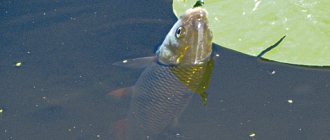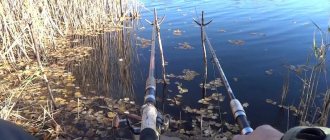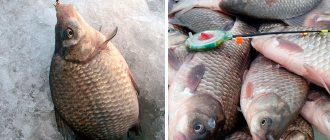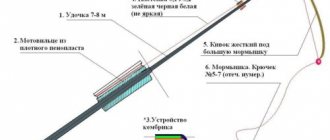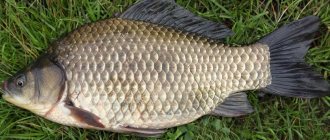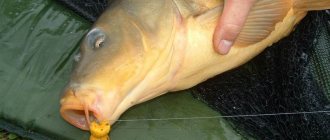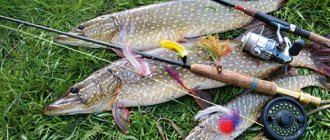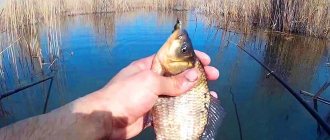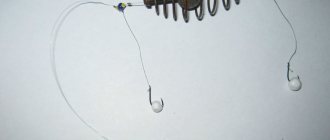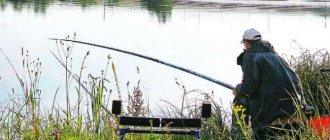In fact, crucian carp has enough enemies, and humans can be included among them.
On any body of water crucian carp can be found:
- In or near areas of aquatic vegetation.
- In areas of the water area where trees or bushes have been knocked down into the water.
- There is clear water in the windows, surrounded by aquatic vegetation.
- In pits, on dumps or tables and other areas with differences in depth.
Small and medium-sized specimens prefer to stay close to the shore, while larger specimens try to stay in the depths and only occasionally approach the shore to feed or sunbathe. But the main condition for his location is the opportunity to hide.
Crucian carp is a very timid fish and at the slightest extraneous noise it leaves its stopping place. The most effective tackle for catching crucian carp is considered to be a float rod. You can catch crucian carp with it throughout the open water season.
Catching crucian carp with corvalol in the reeds | Bites of crucian carp on a float
Catching crucian carp with a float rod
There are several ways to catch crucian carp, such as:
- Flying when using a regular float fishing rod with a blind rig. As a rule, the fishing line used is quite thin with a float of up to 1 gram. The length of the fishing line is chosen equal to the length of the rod or slightly exceeding it. With this rod you can catch crucian carp at a distance of 12 meters from the shore. This fishing method is more suitable for fishing in calm water and in the presence of light wind.
- Plug rod , when a special plug rod is used, consisting of a large number of legs. When fishing for crucian carp, a thin fishing line with a float of 2 grams or more is also used. The length of the fishing line does not exceed the length of the upper leg. This method allows you to very accurately feed crucian carp and catch it at a distance of up to 20 meters. The rod and equipment can be used in any fishing conditions.
- Match , when a fishing rod up to 4.5 meters long, equipped with guide rings, is used. On such rods, spinning reels are installed, with a sufficient supply of fishing line. Such equipment is intended for fishing at long distances, using Wagner-type floats. A match fishing rod can also be used effectively in any conditions.
- Bolognese is more similar to match, although there are minor differences. A telescopic rod is used here, and the method is more suitable for fishing in the current.
In the pond
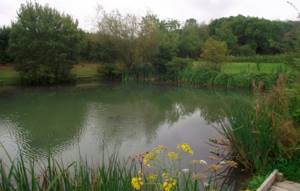
In artificial ponds, crucian carp always appears first. This is due to the fact that it is quite tenacious and can exist in conditions where any other fish simply cannot survive. Therefore, in any hole with water, sooner or later, crucian carp will definitely appear.
In newly formed ponds, where the food supply has not yet been formed, crucian carp moves around the water area in a school, comes close enough to the shore and bites on any bait that is offered to it.
In such reservoirs, crucian carp can be successfully caught using any gear, regardless of the leashes and the thickness of the main line. The only thing that can hinder the crucian bite is the weather, which always makes its own adjustments to the fishing process.
Finding crucian carp in a pond
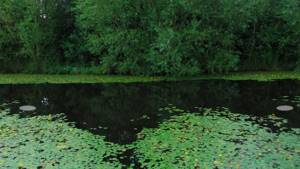
In already established ponds, after some time, other species of fish appear, both peaceful and predatory. In such conditions, crucian carp have to decide on their permanent and temporary stopping places. Therefore, in such ponds you will have to look for crucian carp or attract it to the fishing site with the help of bait.
Baiting is when the future fishing spot is baited for several days in a row. If the food is added regularly, the crucian carp will come to this place on the day of fishing. Unfortunately, this method cannot always be used. It is more suitable for local fishermen who can feed the place at any time.
If this method cannot be implemented, then you can resort to electronic means of determining the location of the fish. In such cases, it is preferable to use an echo sounder.
Lure
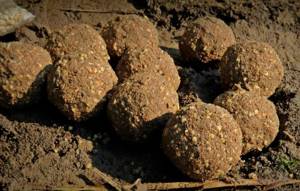
In any case, crucian carp requires a lot of bait, otherwise fishing may not take place. All bait that is planned to attract crucian carp must be divided into three parts. One of these parts needs to be rolled into balls the size of an orange and thrown into the water. Basically, they make a spot bait spot, although there are cases when good results are obtained with a spaced feeding method, when the bait is distributed over a large part of the water area.
The second part of the prepared bait will have to be thrown out in about an hour if there are no bites. In case of bites, the place needs to be fed before each cast.
Video of catching crucian carp with a float rod - secrets : Fishing diary
Carp bait
In carp fishing, feeding plays a very important role.
It is almost impossible to overfeed carp. But in order to reduce the volume of feed, you should use a finely dispersed bait composition, adding large fractions of bait. In the spring, bloodworms or chopped worms are added to the mixture; in the summer, grain baits, boilies, and potatoes are added. In addition to store-bought bait, fishermen attract carp with various cereals, fish feed and mashed potatoes. Adding breadcrumbs and rolled oats to the main bait composition allows you to create a column of turbidity from the surface to the very bottom. Learn recipes for making carp bait.
And professional carp fishermen use special rocket feeders to feed the fishing point, which, when they hit the water, turn over and all the food falls out into the water in the required place.
Tackle
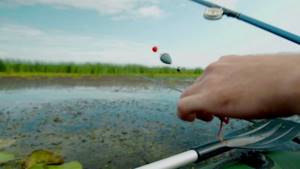
Float gear is the type of gear where it is absolutely impossible to come up with something of your own. The stores have any elements, and they are not at all expensive.
Purchased gear
Almost all the elements of equipment for crucian carp will have to be purchased in the store: this is the rod blank, the main fishing line, fishing line for leashes, sinkers and hooks. Making any fishing rod at home, especially a modern one, is a very difficult task. The only thing you can make yourself is a float from a goose feather. By the way, it is considered the most sensitive float, although it is not suitable for long casting due to its very low weight.
Homemade
Theoretically, you can make a fishing rod by cutting it out of hazel. Firstly, it needs to be dried well, and secondly, this is already a thing of the past, since transporting a long rod is not very convenient. It won’t be possible to make it telescopic, but you can make it foldable, but such a rod will be characterized by poor reliability.
As for the float, it can be made from other materials, such as wine cork, plastic tube, penoplex and others.
Where is crucian carp caught?
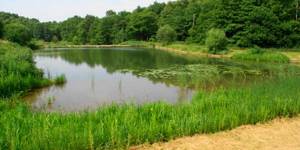
With the arrival of spring, crucian carp prefers places where the water warms up very quickly. As a rule, these are shallow waters, as well as areas with slow currents, at the border of open water and last year’s vegetation.
With the onset of summer, crucian carp can be found:
- In windows of clear water where there is aquatic vegetation
- At the border of clean water and aquatic vegetation
- In areas with differences in depth.
Carp spawning
With the onset of spring flooding of reservoirs, carp leave their wintering pits and rush into the floodplain. A month before spawning, the spawners approach the spawning grounds. They concentrate at a depth of 1.5-2 m in thickets of vegetation and wait for the right temperature to spawn. As soon as the water warms up to 18°C, the mating season begins for the carp. Coastal areas flooded with floods become spawning grounds. Here the depth does not exceed 40-50 cm.
Fish spawn in groups, each of which consists of one female and 2-5 males. Spawning proceeds very rapidly, starting after sunset and ending at 9-10 am. Carp reaches sexual maturity at 3-5 years.
Typically, carp spawn in the second half of May or early summer. The duration of spawning is approximately a month.
When to catch crucian carp
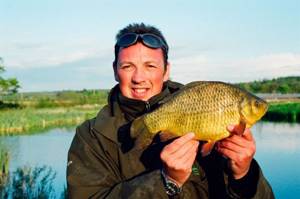
Crucian carp begins to behave actively when the water temperature rises to +10°C, and already at a temperature of +15°C it begins to actively peck.
Crucian carp feels great in conditions where the water temperature is between +18-23°C. It is these indicators that need to be taken into account when organizing fishing.
In spring and autumn, you should also focus on water temperature indicators. As a rule, during these periods he begins to be interested in bait at 10-11 o’clock and until 16-17 o’clock. In the summer, crucian carp begins to bite even before sunrise, and in the evening active biting begins only after 17:00.
But these terms are considered very conditional, since the biting mode of crucian carp is not the same, even if the reservoirs are located nearby. This is due both to the availability of food supply and to the size and depth of the pond.
In ponds where the food supply is poor, crucian carp may be interested in bait throughout the daylight hours.
Fishing. Catching crucian carp with a float rod. My fishing.
Finding a fishing spot
In early spring, you should look for carp in small rivers, where they rush from lakes and ponds after wintering. By the end of spring, the fish like to bask in the sun in the shallows.
In summer, carp habitats are largely determined by weather conditions. In extreme heat, the fish hides in shelters and shady places in the reservoir. And she comes out to feed early in the morning, at night and late in the evening. If the weather is cloudy, the fish feed all day. An important point when searching for carp is its high jumps out of the water.
How to catch crucian carp with a fishing rod in summer?
Fishing always begins with determining where the fish will stay. In addition, you should ask yourself the following questions:
- Are there large crucian carp in the pond?
- Where do fishermen catch it, in what areas of the water area?
- What kind of bait does he use?
- When exactly does a large crucian carp start biting?
Knowing the answers to such questions, you can navigate and correctly decide on gear and attachments.
Preparing the site
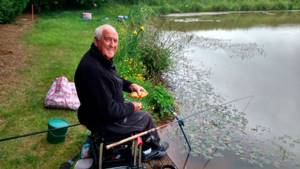
Crucian carp is a shy fish and any extra fuss on the shore will not lead to the desired result. The fishing area should be well equipped, cleared of excess vegetation and debris. If the soil is soft, then it is better to put several boards knocked into one structure in this place.
Rod stands must be installed so that several rods can be controlled without compromising comfort.
The cage and landing net, in case of catching a large specimen, are positioned so that they are nearby and can be reached without any problems.
We should not forget about baits, which should be at hand.
Baits

Crucian carp is an omnivorous fish, so it can bite both baits of plant origin and bait of animal origin. This is especially true for large specimens, for which it is very difficult to select bait. If crucian carp regularly feeds on coastal worms, then catching crucian carp with such baits is not realistic. As for bloodworms, it is good to use when fishing with a regular fly rod, but it is not suitable for long casts - it is too delicate.
Maggot is also a very effective bait. At the same time, it is not as delicate as bloodworms and can be cast using a match fishing rod. But literally all fish love maggots and can simply drive the crucian carp away from the fishing spot. In addition, there are reservoirs where crucian carp bite only on one type of bait.
A worm is the most common and most accessible bait for crucian carp, especially in spring and autumn. In the summer, crucian carp may abandon the worm in favor of plant baits.
The most suitable bait for crucian carp is the red dung worm.
Nozzles
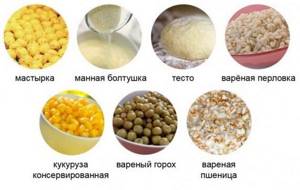
Baits include baits of plant origin. As a rule, they are used only in the summer. It is very rare, but it happens when crucian carp bites on plant baits in the spring.
Pearl barley is widely popular and is suitable for any fishing conditions. To make pearl barley more attractive to crucian carp, before casting it is dipped in breadcrumbs or in a flavoring agent that smells like strawberries or bloodworms.
An equally popular bait is canned corn. Mostly large crucian carp are caught with it. Corn holds well on the hook, therefore, it can be used both in still water and in currents.
Interesting results can be obtained when using the test. It is especially effective in conditions when crucian carp refuses any other bait.
At the same time, the dough is not suitable for fishing at long distances, but at short distances it works very effectively.
Biting calendar
| January | February | March | April | May | June |
| — | — | — | + | +++ | +++ |
| July | August | September | October | November | December |
| +++ | +++ | +++ | +++ | — | — |
Seasonal Fishing Guides
| In the spring, the fish bite is sporadic, but it is before spawning that trophy specimens are often found. Fishing is carried out at shallow depths, where the water warms up well. |
| In the summer, after spawning, carp bite well on vegetable baits (cereals, dough, boilies) away from the shore. It is important to identify the “tables” on which the fish feed. With the right bait, summer becomes the best time for carp fishing. In hot weather, you should go fishing early in the morning, at night or late in the evening. Before a thunderstorm and in drizzling weather, carp bite during the day. |
| In autumn, the bite gets worse as the water temperature decreases. |
| The first carp bites occur among ice fishermen in early spring. At this time, the fish bites on bloodworms, maggots and pieces of worm. But it is caught as by-catch for bream and bream. Purposefully catching carp from the ice is a very difficult task. |
Bait for crucian carp
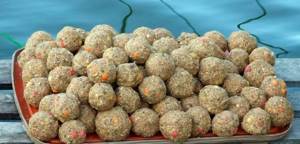
Crucian carp is caught very rarely without bait and in conditions where there are no other fish in the reservoir. If the conditions go beyond the conditions described above, then the crucian carp will have to be attracted using bait.
Purchased bait
Sometimes store-bought baits are criticized because they do not attract fish. In fact, almost all manufacturers test their product in real conditions before offering it to the buyer.
Each producer is fluent in information on the topic of behavior and feeding habits. Unfortunately, baits are produced without taking into account the nature of a particular body of water, which is actually unrealistic. Therefore, any dry mixture can be considered as the basis of bait, to which filler must be added, depending on the actual preferences of the crucian carp regarding a particular reservoir. For example, steamed millet is suitable as a filler, and soil from molehills is suitable as a leavening agent. And, of course, flavoring in the form of crushed bloodworms or worms, as well as hemp.
It is advisable to buy a well-known or “universal” mixture.
Homemade bait
In this case, it is possible to select a recipe, taking into account the nature of the reservoir and the food preferences of the crucian carp. Moreover, the effect can be achieved using the simplest ingredients, such as rye bread, pearl barley or wheat mixed with soil from molehills.
On the river, crucian carp may be interested in steamed millet, combined with hemp seeds. At the same time, it is possible to conduct any type of experiment, with the addition of various components.
Crucian carp may respond positively to various baits that contain birdseed if there is a poultry farm nearby.
Winter fishing. Carp and crucian carp.
Catching carp in winter often happens by accident during winter fishing from ice for other fish using a jig with bloodworms, maggots or something else.
Crucian carp is caught better in winter than carp, but not everywhere. In some reservoirs there is a steady winter bite, but in neighboring ones the crucian carp does not bite all winter, despite the fact that it was successfully caught there in the summer.
Where can you look for these heat-loving carp fish in winter, and what methods should you use to target them? Can winter fishing please you with stable catches of carp and crucian carp?
Let's look at the signs of reservoirs where carp fish were successfully caught in winter.
Which bodies of water are not suitable for winter fishing?
From the number of promising reservoirs for winter fishing, it is necessary to exclude rates and lakes with an unfavorable oxygen regime. Usually they are inhabited only by “swamp” inhabitants, adapted to life in water with a reduced amount of oxygen - crucian carp, rotan and frogs.
Despite the fact that there are a lot of crucian carp in such reservoirs, its numbers prevail over the number of other fish; in winter it is not caught, but buries itself in the silt and hibernates.
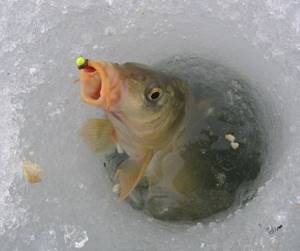
Where are carp and crucian carp usually caught in winter?
It is worth paying attention to reservoirs with a favorable environment. Their main feature is a rich ichthyofauna. In addition to crucian carp and carp, perch, pike perch, chub, as well as bleak, rudd, roach, bream usually live there... The species richness of the reservoir suggests that even in winter the aquatic environment is conducive to the activity of fish, and does not force it to fall into stupor, waiting cold.
The presence of a predator is a factor that speaks in favor of winter fishing at this rate. The predator forces peaceful fish to move even in winter.
Often such reservoirs have a relatively large water inflow and areas with pronounced currents. Usually these are mouths where a river flows into them, as well as places confined to the main channel or outlet of springs. At these points there will be the most oxygen and food for fish. There are also usual places for catching carp and crucian carp in winter.
Conditions are more favorable on the rivers
On rivers, in general, conditions are more suitable for winter fishing, and as a rule, if the river is rich in carp and crucian carp, then their bite does not stop in wintering areas all year round. For successful fishing, you need to know the bottom topography and, of course, the wintering pits where the maximum concentration of fish is observed. Very often on rivers, places of exit from wintering pits, watering areas, and shallow waters near whirlpools are known to local fishermen, who lie in wait for winter carp there.
Next - more details about the characteristics of reservoirs that will help any fisherman assess the prospects of a pond for catching carp fish in winter.
Reservoirs with a warm stream (warm discharge)
Often near cities there is a discharge of warm process water from enterprises. It is known that on the non-freezing stream, which is discharged from power plants, carp are caught all year round. But it’s worth taking a closer look at the ice-covered reservoirs into which water is discharged from a variety of enterprises. And it doesn’t matter whether the pond is small or large, deep or not, the main thing is that there is a warm stream. On a warm and clean watercourse, you can always successfully catch carp fish from under the ice. However, first of all, it is necessary to make an “ecological” inquiry from the “locals” and find out whether polluting water is being discharged. Also, in addition to this, you need to take into account that a warm stream can be dangerous, it washes away the ice, makes it thin and forms holes. Safety measures and caution during winter fishing come first. Therefore, targeting only local fishermen is possible...
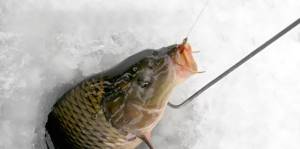
Catching carp in winter is not easy - you need a good body of water and a catchable place...
River-type reservoirs with significant water exchange
The reservoir has a pronounced movement of water - that is, it is a river type. Usually these are small ponds built on rather large streams. Also, such a reservoir can be created by winter from a large pond as a result of water discharge. Moreover, if in the summer the release of water leads to a complete absence of biting, then in the winter a significantly increased water flow and oxygen gain, with a decrease in the food supply and wintering places, forces the fish to move and take the jig. As a result of cracking and subsidence of ice, the water is also significantly enriched with oxygen and fish activity increases. In this case, the frozen bite resumes with renewed vigor, and the cyprinids also wake up. Please note that the pre-spring release of water on many reservoirs is a common practice aimed at preserving the banks and dams before the spring flood. Fish are also activated if the reservoir is filled with water in winter. The water rising and spreading through the shallows causes the fish to move. Starving in a limited area, it wanders to its usual wintering places, to feeding points, where the depth will now be sufficient, and is excellently caught.
Fishing period on the first and last ice
Now let’s pay attention to a fact well known to many winter fishing enthusiasts. Fish can be caught well on the first and last ice. In the middle of winter (in the middle of nowhere), the bite of most fish stops completely, or will be very sluggish. All this is true for carp and crucian carp. The activity of these fish coincides with the activity of other species, therefore, in promising reservoirs, cyprinids need to be tracked during the most favorable periods.
Fishing for carp can be done either with stationary jigs, using nodding or float winter gear, or by playing with jigs.
Giving bait to crucian carp
When fishing with a stationary jig with bait, an indispensable condition is the correct loading of the tackle and its sensitive installation on the reservoir. The winter bite of crucian carp is cautious and slow, but the tackle must register it. The jig needs to be installed under tension so that it barely touches the bottom. With this position, the float or nod should register the most sluggish bites.
If you are not using a jig, then the weight should be placed at a distance of 5–8 cm from the hook. In this case, it is necessary to set the tackle in such a way that there is one hook at the bottom, and the sinker hangs at the bottom.
The nod for fishing with a fixed bait is selected so that its bend when loaded is at least 45 degrees. Only very soft products are used. A significant bending angle is needed to register the most delicate bites. More often, crucian carp bites occur on the rise, while the elasticity of the nod should compensate for the weight of the jig almost completely.
Catching carp in winter using a spoon
For carp fishing, an original method of feeding large bait is known, which can be used in a reservoir with a moderately marshy bottom. You can use a perch spoon as a sinker. Bunches of bloodworms or small worms are attached to the hook of such a spoon.
After casting, a heavy narrow spoon lies on the soft silt and gradually sinks into it, while the hook with a bunch of moving creatures remains on the surface. In this case, the thick fishing line will be spaced from the hook at a distance equal to the length of the spoon. It will not prevent the carp from taking the hook with the bloodworm. It is also possible for the principle of self-notching of carp to work here.
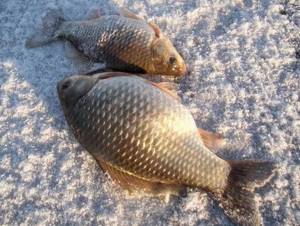
In winter you can successfully catch large crucian carp from under the ice
Game for catching carp from under the ice
The catchability of the playing style is no lower than that of a stationary bait. When playing with a jig, an attachment is not always necessary. You can use artificial decoys - for example, a 2 mm black rubber ball and a bright light cambric. To play, you also need an appropriate fishing rod with a rather harsh nod.
As practice has shown, the most catchy baits are black with a metallic sheen, which contrast the most with the surrounding environment.
Jigs typically use the smallest drop or pellet type, made from tungsten-based alloys, as the heaviest metal available. With sufficient weight, such jigs have the smallest volume. However, for catching carp, you can use baits of various shapes and larger ones, and devils made of lead, with multi-colored threads, beads, cambrics, etc. attached to the hooks.
When fishing for carp fish, moving jigs should be slow and smooth. It consists of rhythmic swaying with low frequency and amplitude, with slowdowns when the bait is lifted upward. Often crucian carp takes the bait when it is not at the bottom, but rather at the top point of its movement.
Bait is also useful in winter
Bait will have a positive effect if you feed the same hole in small portions for several days. A pronounced increase in biting in a newly fed hole is usually not observed.
The bait used is the most simple and not filling. Usually this is a one-to-one mixture of breadcrumbs and sunflower seeds ground into dust. Bloodworms in bait are the most useful thing, but they can also play a negative role if there are a lot of small perch in the pond. Therefore, it is better to use it where this ubiquitous destroyer of living creatures is not available.
At shallow depths, the bait is poured in crumbly form in small portions into the hole. Having formed a slowly settling column of dust, it will attract fish from afar. If the depth is more than 2 meters, then it is better to use a feeder with a hinged bottom. The feeder should be opened when it is 1 - 2 meters from the bottom. During the current, the bait must be lowered to the very bottom in the feeder.
Peculiarities of biting
Usually the bites of crucian carp in winter are very long. The fish savors the bait for a long time, pushes it with its snout, which is expressed in a trembling nod. As soon as the crucian carp has had enough of playing, it nods, which will be the signal to hook. Haste in hooking, as a rule, does not lead to anything good, and the fisherman can only learn to wait for the crucian carp to finally get excited and take the bait confidently.
Carp bite more sharply and pronouncedly. Its bite is hard not to notice. If you don’t even catch carp at the moment, but you came across one in a pond during winter fishing, then you shouldn’t leave your fishing rod unattended. And if you catch carp directly, then you need to release the reel. Otherwise, perhaps such a phenomenon will happen - one moment the fishing rod was standing at the hole and the next second it is no longer there. If you turn away and the fishing rod has disappeared, then you should not suspect neighboring fishermen of this; you need to find out when and how carp was last caught in this reservoir.
Be fully prepared
In winter, carp and crucian carp can be very active, and also predatory and aggressive. Many cases have been described when anglers who had gathered to flash small lures for perch were left without these same lures. And the culprit was a completely unexpected carp. Also, crucian carp are not averse to getting caught on small spoons.
Note that in winter large fish bite more often than in summer. Therefore, if you are planning on carp fish, then you should approach winter fishing fully prepared. If you come across a five-kilogram carp, you can only rely on your tackle. To make it more reliable, the fishing rod should be equipped with a reel with a friction brake, as for summer carp fishing. The hole for catching large fish must be prepared accordingly. And also stock up on a hook with a long handle. Only he can get such a fish into the hole and throw it onto the ice.
Equipment of a float rod for crucian carp
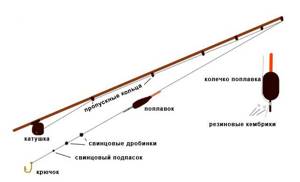
The equipment depends on how you plan to catch crucian carp:
- Main line:
- Swing or plug fishing – diameter up to 0.16 mm.
- Match or Bolognese fishing - diameter up to 0.25 mm.
- Float capacity up to 1 gram:
- When fishing in still water, use a short keel.
- When fishing in the current - with a long keel.
- Sinker pellet . One pellet if a quick immersion of the bait is required and several pellets if the crucian carp is in the water column and not at the bottom.
- A fluorocarbon leash
- Hook No. 8..No. 12 according to the European classification. The size and color of the hook must match the nature of the bait.
Correct and sensitive float loading

To catch crucian carp you need a fairly sensitive float. Loading is carried out at the base of the antenna so that the body of the float is in the water. This will allow you to record the most subtle types of bites.
The float for a match fishing rod is loaded even more, leaving on the surface only a thickening located at the top of the antenna.
Effective float fishing technique
The fishing technique is chosen depending on the nature of the reservoir. If this is a pond without a current, then here you need to throw the tackle into the water and wait for a bite.
When fishing in a current, the task becomes more complicated. Several techniques can be used here. The first option is to fish for crucian carp using wire. To do this, you need to set a certain depth and throw the tackle into the water. Under the influence of the current, the bait will move in the water column at a certain depth.
When fishing in a weak current, holding a line may be more effective, just like when fishing for roach.
Fishing with carp gear
Carp fishing is not just fishing, but a whole philosophy. Its essence can be formulated in one sentence – caring for nature. Therefore, the “catch and release” principle is dominant in such fishing. Carp fishers are focused not on the quantity of fish, but on its quality. those. The weight of the trophy is important to them.
Particular attention should be paid to the choice of fishing location, since fishing is often carried out for several days and the wrong place can ruin the entire fishing trip.
A large number of gear is another attribute of a carp fisher. Their set certainly includes the following gear:
- Rods are from 3.2 to 4.2 meters long, medium action and with a weight of 100 to 200 grams. As with feeder rods, the length depends on the fishing distance. Medium action is most optimal when fishing for carp, as it dampens fish jerks better than fast action rods and has better range compared to slow action rods. Carp anglers use a marker rod to measure the bottom. It has high sensitivity, thanks to which all bottom irregularities are well monitored.
- Method type feeders. Unlike feeder fishing, where mesh feeders are more often used, open feeders are used here.
- Monofilament line with a diameter of 0.30 - 0.50 mm.
- Thick wire hooks.
- Rod-pod or stand for fishing rods. You can attach 2-4 fishing rods to this stand. It is equipped with electronic and mechanical bite alarms.
- Electronic bite alarms. A very convenient thing when fishing for carp. The sound signal can be configured in different tones. This is very convenient, because by the sound you can determine which rod the bite occurred on.
- Powerful carp reels. Such reels have a large fishing spool (you can wind it with, for example, 300 meters of fishing line with a diameter of 0.30 mm) and are equipped with a baitrunner function (thanks to it, the carp will not be able to drag the rod into the water).
- Big landing net. Since the main goal is to catch trophy carp, the size of the landing net should match the fish.
Particularly advanced carp anglers feed the place using a radio-controlled boat. With its help, you can feed any point on the pond without spending a lot of effort. You can also import not only bait, but also equipment.
The most popular bait for this kind of fishing is boilies. They are mounted using hair accessories. Hair installation is specially designed so as not to injure the lips of the carp. Since the hook is located at a distance from the bait, the carp will not be able to swallow the bait deeply. In addition, it is detected on the lower lip, where it has few nerve endings.
Secrets of fishing for crucian carp

Crucian carp has been familiar to many fishermen since childhood. This is a capricious fish that is found in almost all bodies of water. For him, the main condition is the availability of water, and he can always adapt. Moreover, it behaves differently in different bodies of water. To successfully catch crucian carp, you need to study the peculiarities of its behavior in a particular body of water. What is included in this information:
- Areas of water where crucian carp prefer to spend their time.
- Periods when crucian carp are busy feeding.
- His diet.
Based on this information, you can always choose the right tackle, bait and bait. In any case, information can be obtained from experienced anglers if they regularly fish on the pond. Only after careful preparation can you count on a catch.
Igor 05/31/2017

